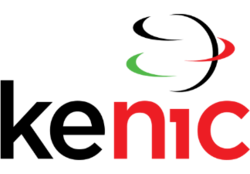KeNIC: Difference between revisions
No edit summary |
No edit summary |
||
| Line 11: | Line 11: | ||
| products = | | products = | ||
| employees = | | employees = | ||
| website = http://www.kenic.or.ke | |||
| blog = https://kenic.or.ke/category/kenic-blog | |||
| email = admin [at] kenic.or.ke | | email = admin [at] kenic.or.ke | ||
| facebook = https://www.facebook.com/Kenictld/ | | facebook = https://www.facebook.com/Kenictld/ | ||
| linkedin = https://www.linkedin.com/in/kenictld/ | | linkedin = https://www.linkedin.com/in/kenictld/ | ||
Revision as of 18:40, 5 March 2021
 | |
| General Information | |
|---|---|
| Industry: | Registry |
| Country: | Kenya |
| Founded: | 1993 |
| Headquarters: | Waiyaki Way, Nairobi |
| Website: | http://www.kenic.or.ke |
| Email: | admin [at] kenic.or.ke |
| Facebook: | |
| Twitter: | [@KenicTLD Twitter] |
| People | |
|---|---|
| Founder(s): | Dr. Shem Ochuodho and Mr. Randy Bush |
Kenya Network Information Centre (KeNIC) is the registry operator for Kenya's .ke ccTLD. It also aims at the development of Internet and other Internet related services in Kenya, with the assistance of various national and international organizations through cooperative agreements, as well as public-private partnerships (PPPs).[1] In addition to these main objectives, KeNIC aims to bring Kenya on equal standards with the global Internet technology with the assistance of the government.[2]
The main advocates for the formation of this nonprofit organization were Dr. Shem Ochuodho and Mr. Randy Bush. KENIC was incorporated in 1993. In October 2001, KeNIC expanded its consultations and services with the assistance of the Communications Commission of Kenya (CCK) and local Internet stakeholders.[2]
Membership[edit | edit source]
KENIC consists of a members board and associate members. Members are drawn from of a mixture of both the Kenyan Internet community and the Kenyan Government.
The board members are selected from internet governance & technological organizations:
- Communications Commission Kenya (CCK)
- TELKOM Kenya
- Government IT Services (GITS)
- Directorate of E-Governance
- Telecommunications Services Providers Association of Kenya (TESPOK)
- Kenya Education Network (KENET)
The Associated members are selected from:
- Kenya ICT Network (KICTANet)
- Domain-Name Registrar Association of Kenya (DRAKE)
- Kenya Internet Marketing Association (KIMA)
Roles of KENIC[edit | edit source]
KENIC was established with the vision of bringing the Kenyan Internet technology up to global standards and to promote Internet and its services in the country on a large scale. KENIC has the following functions:
- To develop and promote .ke ccTLD.
- To create a technological infrastructure for the efficient administration of the .ke ccTLD.
- Manage the .ke TLD, its second level domains and local domains effectively.
- To create a cost-effective environment for the effective growth of .ke.
- Notify the Internet Corporation for Assigned Names and Numbers (ICANN) of any changes to contact information about .ke.
- Allow ICANN to access .ke zone files and registration data .
- Meet all the registration and financial obligations of ICANN.
- Abide with all global ICANN Internet policies.
- Assist ICANN in its development.[3]
.ke[edit | edit source]
The .ke domain is an Open Use ccTLD, with no registration restrictions at the top level.[4] KeNIC supports registrations under several second level domains. There are no restrictions to registering domains under:
- co.ke (intended for companies)
- or.ke (nonprofits/NGOs)
- ne.ke (IoT or network devices)
- me.ke (personal uses)
- info.ke (informational)
- mobi.ke (mobile)[5]
Three SLDs require documentation establishing that the registrant is either a school (ac.ke and sc.ke) or government entity (go.ke) within Kenya.
